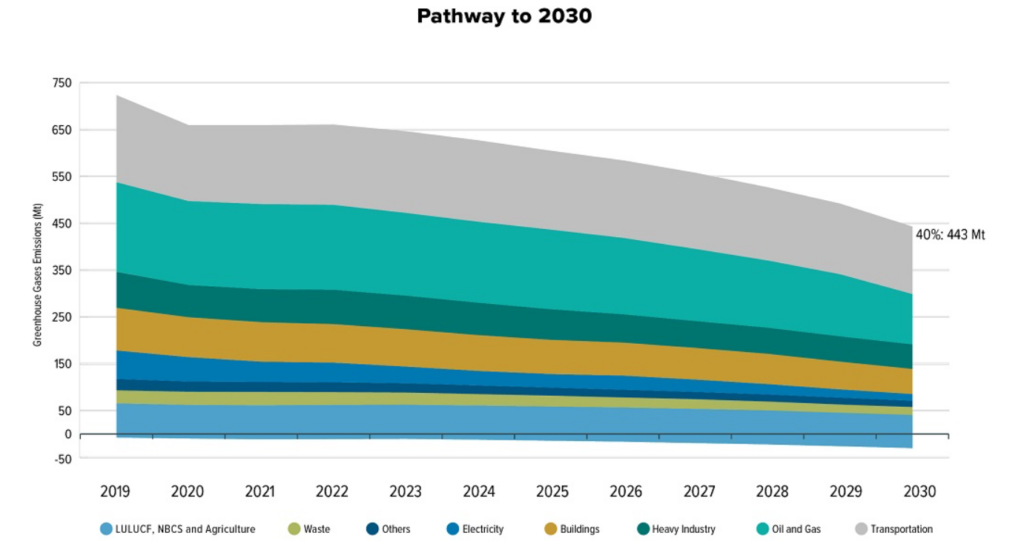On March 29th, the Government of Canada released its 2030 Emissions Reduction Plan – Canada’s Next Steps for Clean Air and a Strong Economy as the country builds towards its net zero goal by 2050. The plan was introduced under the requirements of the Canadian Net-Zero Emissions Accountability Act, which the government implemented in an effort to produce binding climate policies after several years of missed objectives. The reduction plan describes how Canada expects to meet its international climate commitments by achieving an emissions target between 40 and 45 per cent below 2005 levels by 2030 and includes $9.1 billion in new investments to cut pollution and grow the economy.
The highlights of the plan are provided below. Of particular interest to retailers will be policies, programs and incentives relating to green buildings, low carbon funding, zero emission vehicles and renewable electricity.
Take action by helping to reduce energy costs for buildings, while driving down emissions to net zero by 2050 and boosting climate resiliency through the development of the $150-million Canada Green Buildings Strategy. Working with provinces, territories, and other partners, the strategy will build off existing initiatives and set out new policy, programs, incentives, and standards needed to drive a massive retrofit of the existing building stock, and construction to the highest zero-carbon standards.
Will seek to empower communities to take climate action by expanding the Low Carbon Economy Fund through $2.2‑billion in additional funding. The Low Carbon Economy Fund will look to leverage further climate actions from provinces and territories, municipalities, universities, colleges, schools, hospitals, businesses, not-for-profit organizations, and Indigenous communities and organizations.
The government is proposing more aggressive action to get Canadians to adopt Zero Emission Vehicles (ZEVs) and has committed to spending $1.7 billion to extend credits for the purchase of both cars and trucks. The government also plans to implement a sales mandate for vehicles as follows:
- Light-duty vehicles – at least 20% of sales will be ZEVs by 2026, 60% by 2030 and 100% by 2035
- Medium and heavy-duty vehicles – at least 35% of sales will be ZEVs by 2030
Powering the economy, including buildings and vehicles with renewable electricity, will be key to Canada reaching its net zero goal by 2050. To ensure success, the Government of Canada will work with provinces and utilities to establish a Pan-Canadian Grid Council to promote clean electricity infrastructure investments. Additionally, the Government of Canada will invest an additional $600 million in the Smart Renewables and Electrification Pathways Program and $250 million to support predevelopment work for large clean electricity projects.
The largest contributor of greenhouse gas emissions in Canada is the oil and gas sector. As of 2019, oil and gas represented 26 per cent of national emissions. The plan includes sector specific emission reductions to 31 percent below 2005 levels in 2030 (or to 42 percent below 2019 levels) and the government will be engaging with key stakeholders to take this forward.
The government will aim to implement carbon capture, utilization, and storage (CCUS) strategy; introduce an investment tax credit to incentivize the uptake of carbon storage technology; and invest $194 million to expand the Industrial Energy Management System to support the adaptation of ISO 50001 certifications across industry.
The government has committed to $780 million for the Nature Smart Climate Solutions Fund to deliver additional emission reductions from nature-based climate solutions. This includes conserving and restoring wetlands, peatlands, and grasslands to store and capture carbon.
The government has committed to $1 billion for new and expanded programs to help the agricultural sector develop and adopt sustainable practices, energy-efficient technologies, and solutions like capturing carbon from the air.
The 2030 plan commits to exploring measures that help guarantee the price of pollution, including investment approaches, like carbon contracts that incent low-carbon project investors by de‑risking private sector low-carbon investments.
A summary of Canada’s pathway to its 2030 reduction plan by sector is provided below:

